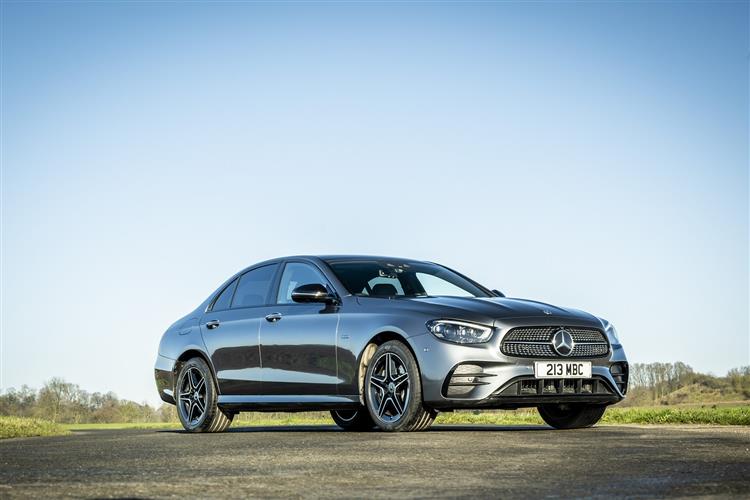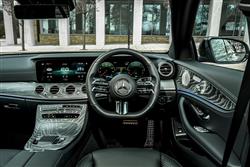How will you view?
This is a sample, showing 30 seconds of each section.
DIESEL'S LAST STAND (some text hidden) SECTIONED_new_mercedese300deeqpower_2021
By Jonathan Crouch
Introductionword count: 102
Only Mercedes sold a diesel-powered plug-in hybrid powertrain in this century's second and third decades - and only the E-Class offered it in the full-Executive segment, in the form of this E300 de EQ Power model, examined here in the facelifted post-'20-era version of the fifth generation W213-series model. You might have an aversion to diesel engines, and/or plug-in hybrid power. But if you haven't and you're browsing in this segment amongst models from the 2020-2023 period for an efficient, prestigious saloon or estate premium brand PHEV contender, it's hard to escape the conclusion that this one offers something really rather interesting.
Modelsword count: 9
4dr Saloon / 5dr Estate (3.0 diesel [E300 de])
Historyword count: 186
Why would you develop a powertrain that partly uses electric power, then hobble it with a thirsty petrol engine whenever that battery energy runs out? That's just what virtually every plug-in hybrid model on the market does, almost all brands linking battery power to a petrol combustion engine. Only Mercedes ever also offered customers an alternative; PHEV models with diesel power. As an environmental solution, you might think this to be either a contradiction in terms or a rather clever idea, depending on which side of the current global warming zeitgeist you happen to sit. If you consider it a clever idea and you're browsing in the full-sized Executive segment for a premium badged saloon or estate of this type from the 2020-2023 period, you'll want to consider this model, the Mercedes E300 de EQ Power. The 'W213'-series E-Class range had been launched in 2016, with E300 de plug-in model's powertrain added to the range after launch. Here, we're looking at the post-'20-era facelift version of that model, which sold (alongside an E300e petrol plug-in model) until a new generation MK6 E-Class design arrived in mid-2023.
What You Getword count: 396
There are no outward giveaways as to this model's plug-in status, unless you happen to notice the badging or the extra filler flap. It was part of a 'W213'-series E-Class Saloon and Estate range that back in 2020 had recently been significantly updated. The swept-back power domed bonnet flows down into a grille that as part of this update was turned upside down, becoming wider at the bottom than the top. In profile, this remained a stylish piece of design, the powerfully-extended silhouette characterised by short overhangs, a long wheelbase, large wheels and taut, well-defined flanks. The alternative Estate version adds 10mm of length. At the rear, as part of the W213 facelift, the saloon body shape gained much wider, now horizontally-orientated LED tail lamps that got segmented by a restyled boot lid and sat above a revised bumper. Inside, the main change with this revised version of the W213-series model, apart from a revised steering wheel, lay with the adoption of the brand's MBUX operating system for its so-called 'Widescreen Cockpit' dash design. This became an intuitive set-up with artificial intelligence capabilities able to predict what the user would like to do next. It uses two 12.3-inch displays, one for the instrument cluster and one for the central MBUX infotainment screen, blended beneath a shared glass cover. As always with an E-Class, everything does of course all feel suitably premium, with leather upholstery and heated front seats being standard fit on all variants. There's also a lovely 64-colour ambient lighting system, with LED strips along the bottom of the fascia, on the door cards and along the side of the centre console that give the cabin a very special feel after dark. In the rear, passenger space is generous. If the front passengers have their seats at the lowest setting, you might find room for your feet slightly limited, but otherwise the rear foot wells are big and broad. There's an issue with boot space though, which falls substantially over what you'd get from an ordinary W213 combustion model, thanks to the need to house the PHEV system battery beneath the floor. The saloon model's trunk space falls from 540-litres to just 370-litres (less than you'd get in a Golf), though you can fold forward the 40:20:40-split rear backrest to extend it. The Estate model's usual 640-litres falls to 480-litres (1,660-litres with the seats folded).
To see the full road test text contact us on 0330 0020 227
Pictures (high res disabled)

.jpg)
|
.jpg)
|
.jpg)
| |||
.jpg)
|
.jpg)
|
.jpg)
| |||
.jpg)
|
.jpg)
|
.jpg)
| |||
.jpg)
|

|
Scoring (subset of scores)
Category: Hybrid, Plug-in, Electric & Hydrogen
| Performance | |
| Handling | |
| Comfort | |
| Space | |
| Styling, Build, Value, Equipment, Depreciation, Handling, Insurance and Total scores are available with our full data feed. | |



